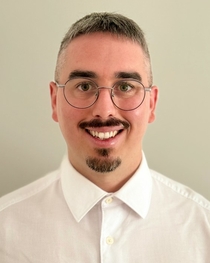If you experience issues with a vTools.eNotice mailing that originates from vTools.Events, please contact staff for assistance.
Non-invasive Biomarkers Measurement by Electromagnetic Means: Past, Present and Future
During the last years we have witnessed unprecedented advancements of electronic technology in many fields of application, and particularly in the biomedical realm. Among the countless possibilities, the technologies based upon the propagation of electromagnetic fields, such as microwaves or millimeter waves, raise as potential instruments as for non-invasive measurement of certain biomarkers.
During this lecture, we will acquaint ourselves with the fundamental principles of operation of these technologies, with a particular focus on the measurement of blood glucose concentration, the quintessential marker for diabetes management. Indeed, self-measuring the blood glucose level (BGL) is part and parcel of diabetes daily routines. Currently, most of the measuring methods are invasive and uncomfortable, often leading to a reduced, intermittent number of measurements. The development of a reliable non-invasive method able to provide the user with their BGL in a comfortable way, with capabilities of continuous BGL measurement, seems therefore highly desirable.
Date and Time
Location
Hosts
Registration
-
 Add Event to Calendar
Add Event to Calendar
- Calle de la Concha, 44
- Aranjuez, Madrid
- Spain 28300
- Building: Hospital de San Carlos
- Room Number: Salón de Actos (HS03)
- Contact Event Host
- Co-sponsored by SAAEI 2025
Speakers
Carlos G. Juan of IEEE IMS Spain Chapter
Non-invasive Biomarkers Measurement by Electromagnetic Means: Past, Present and Future
During the last years we have witnessed unprecedented advancements of electronic technology in many fields of application, and particularly in the biomedical realm. Among the countless possibilities, the technologies based upon the propagation of electromagnetic fields, such as microwaves or millimeter waves, raise as potential instruments as for non-invasive measurement of certain biomarkers.
During this lecture, we will acquaint ourselves with the fundamental principles of operation of these technologies, with a particular focus on the measurement of blood glucose concentration, the quintessential marker for diabetes management. Indeed, self-measuring the blood glucose level (BGL) is part and parcel of diabetes daily routines. Currently, most of the measuring methods are invasive and uncomfortable, often leading to a reduced, intermittent number of measurements. The development of a reliable non-invasive method able to provide the user with their BGL in a comfortable way, with capabilities of continuous BGL measurement, seems therefore highly desirable.
In this sense, we will see how the scientific community is endeavoring to develop a suitable technological solution for the craved non-invasive measurement of glucose concentration, leveraging the benefits of electromagnetic technologies. During our review of the battle against this technical challenge, we will focus on:
• The scientific foundations of remote measurement by electromagnetic means, underlining the interesting properties of microwaves and millimeter waves for the particular requirements of biomedical contexts.
• The main sensing approaches, with the resonator as the overarching element for these measurement systems.
• The initial works demonstrating the measurement of glucose concentrations in aqueous and biological solutions.
• The current challenges, including path-breaking human trials, sensitivity boosting and selectivity analysis.
• The required instrumentation and driving electronics for such devices in out-of-the-lab applications.
• Other potential applications of these instrumentation and measurement systems for biomarkers detection.
• The zestful future prospects and expectations in the burgeoning pursue of reliable non-invasive BGL measurement, especially considering the arrival of modern artificial intelligence techniques.
All in all, we will show that the desired non-invasive, continuous BGL measurement might no longer be a figment of our imagination in the near future. With intriguing ongoing research and technological advancements, we will highlight the potential of current electromagnetic technologies for instrumentation and measurement purposes in the biomedical domain. This talk will allow us to gain insights on the basic working principles that inspired the past pioneering works, made possible the current thrilling advancements, and will facilitate the unthinkable future applications.
Biography:

He was a Visiting Researcher with the Lab-STICC Group, Université de Bretagne Occidentale (UBO), Brest, France, in 2016 and 2018. During 2019–2020 he was an Adjunct Professor with the Dept. of Materials Science, Optics and Electronic Technology, UMH. He held several Postdoctoral Research Fellowships with Lab-STICC, UBO, Brest, France (2020–2021), Medical Robotics Group, University of Málaga, Spain (2022) and Technical University of Cartagena, Spain (2023–2024). Since Sept. 2024 he is a “Ramón y Cajal” Senior Research Fellow with the Institute of Bioengineering, UMH. His main research interests include microwave engineering, antenna and propagation, instrumentation electronics and sensors applied to bioengineering.
Dr. Juan was a recipient of the CEA-Springer Award to the Best PhD Thesis in Bioengineering 2020, the Santander Bank Young Researchers Award 2022, the Extraordinary Ph.D. Award 2022, or the IEEE Trans. Instrum. Meas. Outstanding Associate Editor Award 2023, among other awards and distinctions. He authored the book Glucose Concentration Detection in Aqueous and Biological Solutions with Microwave Sensors: An Approach towards Non-invasive Glucose Sensing (Springer, 2021). He served as an Associate Technical Program Committee Chair at the IEEE Int. Instrum. Meas. Technol. Conf. (I2MTC) 2024. He currently serves as an Associate Editor for IEEE Trans. Instrum. Meas.
Email:
Address:Miguel Hernández University of Elche, , Elche, Spain
